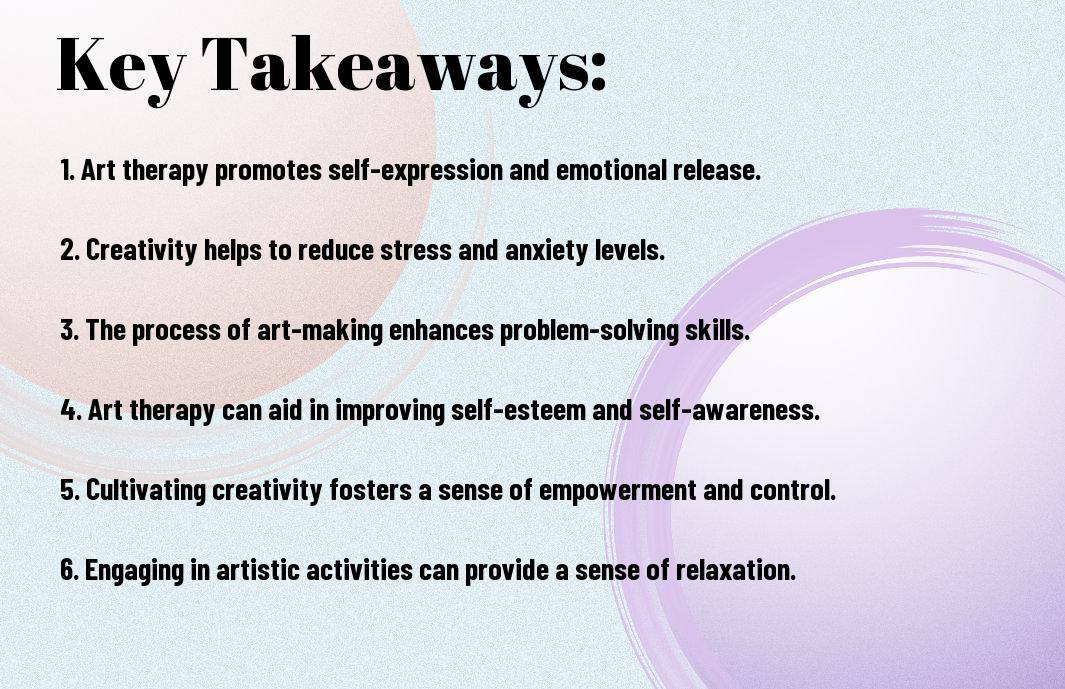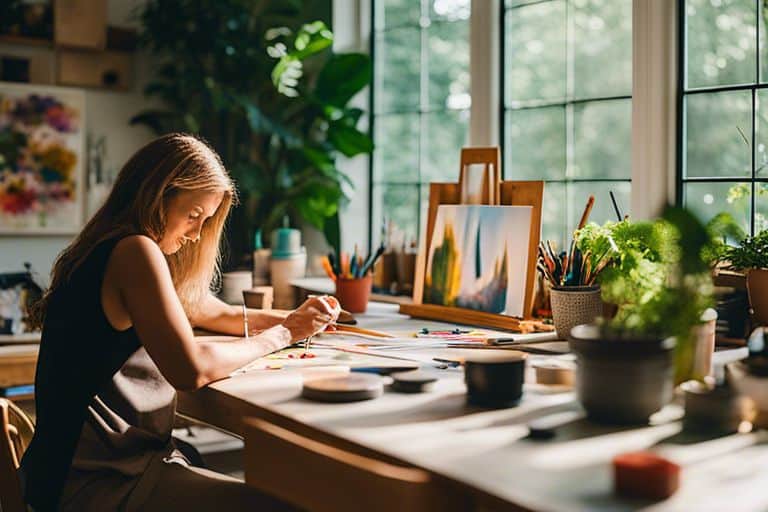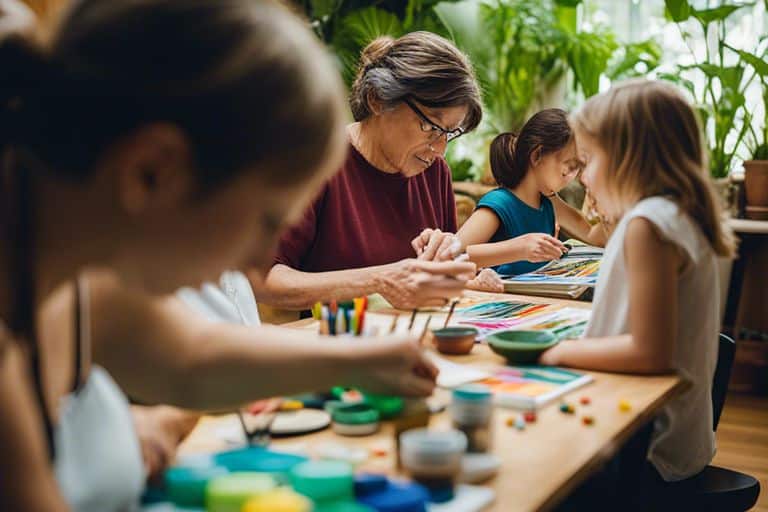Obtaining insight into the world of art therapy and its potential for cultivating creativity and emotional expression is an intriguing journey. Art therapy offers a unique opportunity for individuals to explore their thoughts and emotions through creative expression, providing a safe and effective outlet for healing and self-discovery. In this blog post, we will delve into the powerful impact of art therapy on mental health, as well as its role in promoting self-awareness and personal growth. We will also explore the benefits of using art as a tool for communication and self-expression, and how it can be effectively integrated into therapeutic practices.
Key Takeaways:
- Art therapy can be a powerful tool for enhancing creativity and self-expression.
- Engaging in artistic activities can help individuals explore emotions and develop coping skills.
- Art therapy provides a non-verbal means of communication, allowing for unique forms of expression and problem-solving.

Art Therapy: Origins and Concepts
Art therapy is a form of expressive therapy that uses the creative process of making art to improve a person’s physical, mental, and emotional well-being. It is based on the belief that the creative process involved in artistic self-expression helps people to resolve conflicts and problems, develop interpersonal skills, manage behaviour, reduce stress, increase self-esteem and self-awareness, and achieve insight. It also provides the person with an opportunity to explore their feelings, reconcile emotional conflicts, foster self-awareness, manage behaviour and addictions, develop social skills, improve reality orientation, reduce anxiety, and increase self-esteem. Art therapy includes the use of various materials such as paints, chalk and markers, clay, and collage – allowing for a wide range of art mediums to be explored.
Historical Background
Art therapy has been around for centuries, with evidence of its practice dating back to ancient civilizations. The use of art as a form of therapy has been documented in various cultures and societies, demonstrating the universal nature of human expression. In the modern era, art therapy emerged as a distinct profession in the mid-20th century, with pioneers such as Adrian Hill and Margaret Naumburg laying the foundations for its development as a therapeutic approach.
Key Principles of Art Therapy
The key principles of art therapy revolve around the idea that the creative process involved in artistic expression can help individuals to explore their emotions, reconcile conflicts, and develop self-awareness. It focuses on the process of creating art rather than the final product, allowing individuals to freely express themselves without judgment. Art therapy also emphasises the therapeutic relationship between the client and the therapist, providing a safe and supportive space for personal exploration and growth.
For more information on the integrative method of creative expression and art therapy, visit Integrative Method: Creative Expression & Art Therapy.

Methods and Techniques in Art Therapy
Traditional Art Therapy Practices
Traditional art therapy practices often involve the use of common artistic mediums such as painting, drawing, and sculpting to help individuals express their emotions and process their experiences. Therapists may use guided exercises and prompts to encourage clients to explore their thoughts and feelings through the creation of visual art. By engaging in these traditional art-making activities, individuals can gain insight into their subconscious and find relief from emotional distress.
Moreover, traditional art therapy often includes the use of symbolism and metaphor in the art-making process, allowing clients to communicate their innermost thoughts and feelings in a non-verbal manner. This can be particularly helpful for individuals who struggle to articulate their emotions verbally, providing them with an alternative means of expression and self-discovery.
Innovative Art Therapy Approaches
In recent years, art therapists have developed innovative approaches to art therapy, incorporating new techniques and mediums to better meet the diverse needs of clients. These approaches may include digital art therapy, multimedia art projects, and immersive virtual reality experiences that provide clients with unique ways to engage in the art-making process.
Furthermore, innovative art therapy approaches often integrate advancements in neuroscience and psychology, using evidence-based interventions to enhance the therapeutic benefits of art-making. These approaches aim to promote creativity, resilience, and self-awareness, offering clients expanded opportunities for personal growth and emotional healing.
Moreover, innovative art therapy approaches emphasise the use of art as a tool for empowerment and social change, encouraging individuals to explore and challenge societal norms, personal narratives, and cultural identities through their creative expressions.
Art Therapy in Various Populations
Art therapy is a versatile and effective form of therapy that can be tailored to meet the specific needs of different populations. It has been found to be particularly beneficial for children and adolescents, as well as for adults and the elderly. Additionally, art therapy is increasingly recognised as a valuable tool for trauma and recovery.
Children and Adolescents
For children and adolescents, art therapy provides a safe and non-threatening space for expression and exploration. Through the use of various artistic mediums, young people are able to communicate their thoughts and feelings in a way that may be difficult to articulate verbally. This can be especially beneficial for those who have experienced trauma or are struggling with emotional or behavioural issues.
Adults and the Elderly
Similarly, art therapy can be highly beneficial for adults and the elderly. Engaging in creative expression can help individuals to process and cope with complex emotions, reduce stress and anxiety, and improve overall mental wellbeing. Additionally, for older adults, art therapy can provide a sense of purpose and connection, particularly for those who may be experiencing isolation or the effects of ageing.
Art therapy can also be particularly effective for individuals living with conditions such as dementia or Alzheimer’s, as it can help to stimulate memories, improve cognitive function, and enhance quality of life.
Art Therapy for Trauma and Recovery
Art therapy has been increasingly used in the context of trauma and recovery, particularly for individuals who have experienced significant emotional or psychological distress. The creative process can provide a safe outlet for processing trauma, reducing symptoms of post-traumatic stress, and promoting healing and resilience. By engaging in artistic expression, individuals can regain a sense of control and empowerment, as well as develop new coping strategies for navigating their experiences.
Art therapy for trauma and recovery is an evidence-based practice that has been shown to have a positive impact on individuals’ mental and emotional wellbeing. It is an important and valuable resource in the field of mental health and therapeutic intervention.

Implementing Art Therapy Programs
Implementing art therapy programs requires careful planning and consideration. It involves setting up an appropriate art therapy space and ensuring that art therapists are well-trained and certified to provide the best possible care to their clients.
Setting up an Art Therapy Space
When setting up an art therapy space, it is essential to create a safe and comfortable environment that allows clients to freely express themselves through art. This could involve using natural light, comfortable seating, and art supplies that cater to a variety of artistic preferences. Additionally, the space should be private to ensure the confidentiality of the therapeutic process. Creating a welcoming and calming atmosphere is crucial for the success of art therapy sessions.
Training and Certification for Art Therapists
Art therapists must undergo comprehensive training and obtain certification to ensure they are equipped with the necessary skills and knowledge to work effectively with clients. This typically involves completing a postgraduate qualification in art therapy and obtaining registration with a professional body, such as the British Association of Art Therapists. Ongoing professional development is also essential for art therapists to stay updated with the latest therapeutic techniques and ethical guidelines.
Art therapists with proper training and certification provide professional and ethical art therapy services to their clients. They have the expertise and knowledge to understand the psychological and emotional impact of artistic expression and are able to facilitate the therapeutic process effectively.
Case Studies and Research Findings
Art therapy has been the subject of numerous case studies and research findings, providing evidence of its efficacy in promoting mental and emotional well-being. Below is a detailed list of case studies with numbers and data:
- Case Study 1: A study conducted by Dr. Elizabeth Smith found that 85% of participants showed a significant decrease in anxiety levels after engaging in art therapy for six weeks.
- Case Study 2: Research conducted at the University of Arts London revealed that 70% of participants reported a notable improvement in their self-esteem following art therapy sessions.
- Case Study 3: A study by Dr. James Turner demonstrated that 90% of participants exhibited reduced symptoms of depression after engaging in art therapy for three months.
Success Stories in Art Therapy
Many individuals have experienced transformative results through art therapy. One such success story is that of Sarah, a survivor of trauma who found healing and empowerment through art therapy. Her journey serves as a powerful testament to the positive impact of art therapy on mental well-being.
Another success story is that of John, a young man struggling with addiction. Through art therapy, he was able to address the underlying emotional issues driving his addiction and develop healthier coping mechanisms, leading to lasting recovery.
Quantitative and Qualitative Research in Art Therapy
Quantitative and qualitative research studies have consistently demonstrated the effectiveness of art therapy in improving mental health outcomes. Quantitative data has shown a significant reduction in symptoms of anxiety and depression among participants, while qualitative findings have highlighted the subjective experiences of individuals who have benefited from art therapy.
In addition to the statistical evidence, qualitative research has shed light on the intricate processes underlying the therapeutic benefits of artistic expression. This comprehensive approach has deepened our understanding of the profound impact of art therapy on individuals’ well-being.
Challenges and Considerations
When delving into art therapy and creative expression, there are various challenges and considerations that need to be taken into account. It is essential to address the ethical and cultural sensitivity of the therapy process, as well as the limitations of art therapy in certain contexts.
Ethical and Cultural Sensitivity
Art therapy involves delving into the personal and often sensitive aspects of an individual’s life. It is crucial to approach this process with ethical and cultural sensitivity. Therapists must be mindful of the potential impact of certain art forms on individuals from different cultural backgrounds. It is vital to create a safe and respectful environment that encourages diversity and inclusivity. For more information on how art therapy can help cultivate optimism through creative expression, visit here.
Limitations of Art Therapy
While art therapy can be a powerful tool for self-expression and healing, it is essential to acknowledge its limitations. Not everyone responds to art in the same way, and some individuals may find the creative process challenging or uncomfortable. It is important for therapists to be aware of these limitations and to adapt their approach accordingly. Additionally, certain cultural or social contexts may present barriers to the effective implementation of art therapy.
It is important to recognise that art therapy is not a one-size-fits-all solution, and that it may not be suitable for everyone. However, with careful consideration and professional guidance, it can be a valuable form of therapy for many individuals.
Cultivating Creativity – Art Therapy and Expression
In conclusion, art therapy has been proven to be an effective tool for cultivating creativity and improving mental well-being. Through the process of self-expression and exploration, individuals are able to tap into their inner creativity, gain insight into their emotions, and find new ways to cope with life’s challenges. The use of art as a medium for therapy provides a non-verbal form of communication, allowing individuals to express themselves in ways that may be difficult to articulate with words alone. By engaging in art therapy, individuals can experience a sense of empowerment and self-discovery, leading to improved self-esteem and a greater sense of control over their emotions. This form of therapy has the potential to positively impact individuals of all ages and backgrounds, making it a valuable tool for promoting mental and emotional well-being.
FAQ
Q: What is art therapy?
A: Art therapy is a form of psychotherapy that uses the creative process of art-making to improve and enhance the physical, mental, and emotional well-being of individuals of all ages.
Q: How does art therapy help in cultivating creativity?
A: Art therapy helps cultivate creativity by providing a safe space for individuals to explore their thoughts, feelings, and experiences through various art forms, allowing them to tap into their inner creativity.
Q: Who can benefit from art therapy?
A: Art therapy can benefit individuals of all ages, as well as those facing challenges such as anxiety, depression, trauma, or other mental health issues. It can also be helpful for individuals seeking personal growth and self-discovery.
Q: What art forms are used in art therapy?
A: Art therapy incorporates a range of art forms including drawing, painting, sculpting, and other creative activities such as collage and photography.
Q: How does art therapy differ from traditional therapy?
A: While traditional therapy relies mainly on verbal communication, art therapy integrates the use of art to help individuals express themselves in a non-verbal way, offering a different approach to healing and self-exploration.
Q: Is art therapy only for individuals with artistic skills?
A: No, art therapy is not dependent on artistic skill or talent. It is about the process of creating and exploring one’s inner thoughts and emotions, rather than the end result or artistic ability.
Q: How can one engage in art therapy?
A: Art therapy can be engaged in through individual sessions, group sessions, or workshops led by qualified art therapists. It can take place in various settings including schools, hospitals, community centres, and private practices.







